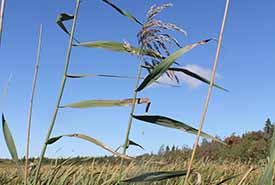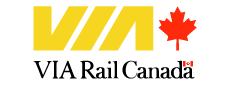Combating Invasive Species

invasive phragmites (Photo by NCC)
For the Nature Conservancy of Canada, (NCC), acquiring land is just the beginning when it comes to protecting Canada’s natural habitats. Caring for the land is just as important; this includes protecting against invasive species.
Invasive species are the second biggest threat to native biodiversity.
Invasive species are non-native species that spread aggressively and can alter Atlantic Canada's natural habitats. They can be plants, insects, animals or even diseases introduced into a new area where they cause harm. With no natural predators to control them, they can outcompete native plants and animals and alter how ecosystems function.
Invasive species are largely spread by humans, usually unintentionally. Some of the impacts of invasive species in Atlantic Canada include:
- The loss of 99 per cent of the little brown bat population, with the introduction of white-nose syndrome.
- Threats to our forests from brown spruce longhorn beetle and emerald ash borer.
- Changes to our rivers and lakeshores with the spread of Japanese knotweed and glossy buckthorn.
Why are invasive species harmful?
- They alter natural habitat and food for wildlife.
- They can decimate native species and are a threat to some species at risk.
- They reduce agriculture productivity.
- They decrease property value.
- They increase property and infrastructure maintenance costs.
- Some are potentially toxic to animals or cause allergies in humans.
- They destroy recreational opportunities and the aesthetics of the landscape.
How do invasive species spread?
- In the fur or excrement of livestock, wildlife and pets.
- On vehicles, ATVs, snowmobiles and boats.
- On the boots of hikers or wheels of bikes.
- In water that collects in boats and gear (buckets, bilge, ballast, etc.).
- On firewood.
- As escaped ornamental or garden plants.
- By releasing non-native animals in the wild.
Be a part of the solution!
You can help protect our natural areas from these nasty invaders. Once invasive species spread, their management and removal are exponentially more expensive and less efficient. The first step each of us can take is to prevent their introduction or spread. It is much less costly when we invest in prevention and early detection efforts. Here are some ways you can help:
- Avoid planting invasive species in your garden and dispose of invasive plants waste responsibly.
- Remove plant fragments, seeds and mud from your clothing, shoes, tires, and pets when leaving an area.
- Drain any water from boats and gear; clean and dry your boat/gear before entering a new waterway.
- Buy or gather firewood as close as possible to where you intend to burn it.
- Use iNaturalist to help report and identify invasive species.
- Become an NCC volunteer. Learn more>
- Support NCC’s ongoing efforts. Make a donation>
You can support NCC’s work with partners across the Maritimes to map the extent of invasive plants and remove them to restore habitat on protected land. Together, we can make a difference in conserving biodiversity. Your gift to NCC can help unlock critical matching funds to complete on-the-ground activities to care for the health of the land.
To support this work, please contact: 1-877-231-4400 ext. 3307 (Amanda) or atlantic@natureconservancy.ca
Our partners
- Nova Scotia Invasive Species Council
- New Brunswick Invasive Species Council
- PEI Invasive Species Council
- Canadian Food Inspection Agency



